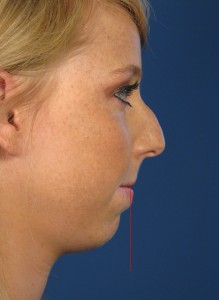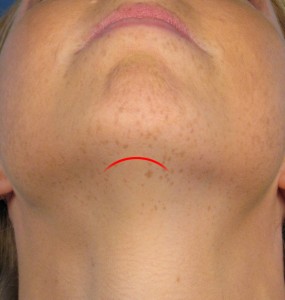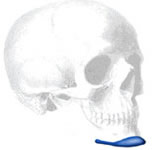 Chin augmentation using an implant is a cosmetic enhancement procedure intended to provide more definition along the jaw and upper neck region. Since the chin is sometimes referred to as the mentum, this facial implant procedure has also been called a mentoplasty by some plastic surgeons.
Chin augmentation using an implant is a cosmetic enhancement procedure intended to provide more definition along the jaw and upper neck region. Since the chin is sometimes referred to as the mentum, this facial implant procedure has also been called a mentoplasty by some plastic surgeons.
Most patients contemplating chin implant surgery have concerns with their chin appearing too weak or underdeveloped for their face. Some complain that their chin looks too recessed, particularly when seen from the side (profile) view. Chin implant patients commonly note they lack definition along the lower one-third of their face compared with the middle and upper one-third. This is because the upper, middle and lower thirds of the face should be relatively equivalent in terms of size. If a poorly developed chin makes the lower one-third appear recessed, the overall balance and harmony of the face can be disrupted. In some chin implant patients this imbalance can be quite obvious while in others it is a more subtle finding. When a patient has an excessively short neckline and/or a larger than average nose, the weak chin can oftentimes be exaggerated in appearance.
Evaluation for Chin Implant
Evaluation of the patient considering chin implant surgery begins with our facial plastic surgeon assessing the overall facial balance. This is primarily done when looking at the profile view of the face, although the oblique (45 degree angle) view is also telling in most cases. The frontal view can also reveal the imbalance in the lower one-third of the face, but it is not as obvious in most patients since the chin becomes blended into the background of the face.
 The adjacent photo demonstrates this concept visually when looking at the profile view. This is a patient who desired chin implant surgery to enhance the definition of her jaw. As you can see in the photo, her chin is underdeveloped and creates an imbalance in her lower face. She also happens to be a patient who has a bump on her nose, which further exaggerates the recessed chin. When looking specifically at the chin, we draw an imaginary vertical line (indicated in red) through what we call the red-white junction – which is the most anterior (forward) point where the red portion of the lower lip meets the white portion. If a plumb line is drawn straight down from this point, you can get an idea of just how recessed the chin really is. In male patients, the chin should project forward to within a few millimeters of this imaginary line or just at the line. In some male patients, they can even tolerate going slightly beyond this line. In female patients, the chin should come forward nearly to this line, but should remain 2-4 millimeters behind it to be considered ideal.
The adjacent photo demonstrates this concept visually when looking at the profile view. This is a patient who desired chin implant surgery to enhance the definition of her jaw. As you can see in the photo, her chin is underdeveloped and creates an imbalance in her lower face. She also happens to be a patient who has a bump on her nose, which further exaggerates the recessed chin. When looking specifically at the chin, we draw an imaginary vertical line (indicated in red) through what we call the red-white junction – which is the most anterior (forward) point where the red portion of the lower lip meets the white portion. If a plumb line is drawn straight down from this point, you can get an idea of just how recessed the chin really is. In male patients, the chin should project forward to within a few millimeters of this imaginary line or just at the line. In some male patients, they can even tolerate going slightly beyond this line. In female patients, the chin should come forward nearly to this line, but should remain 2-4 millimeters behind it to be considered ideal.
In situations where the chin is more recessed than desired, a chin implant procedure may be indicated to help project the chin forward and provide improved balance and definition.
Chin Implant Surgery
Chin implants are typically placed using one of two different approaches. Some plastic surgeons use what is called a trans-oral technique, which means the incision is made inside of the mouth to place the implant. Although this approach can be successful in many cases, there is a higher risk of infection since, by definition, the mouth cannot be sterilized.
 A more preferred technique for placement of the chin implant involves making a hidden incision under the chin. This is called a submental approach since it involves going from underneath the mentum, or chin. This is shown in the adjacent photo as indicated by the slightly curved red line. Most patients have a natural skin crease just below the chin that can be used to help hide the incision so that the scar is barely visible once healed. In addition, the incision is actually under the chin, which is going to be projected forward with the implant thereby making the incision even less noticeable. This is also an area that can be effectively sterilized prior to the procedure so the risk of infection is greatly minimized. Furthermore, this technique provides a more direct approach to the jaw, which arguably allows for more accurate placement of the chin implant.
A more preferred technique for placement of the chin implant involves making a hidden incision under the chin. This is called a submental approach since it involves going from underneath the mentum, or chin. This is shown in the adjacent photo as indicated by the slightly curved red line. Most patients have a natural skin crease just below the chin that can be used to help hide the incision so that the scar is barely visible once healed. In addition, the incision is actually under the chin, which is going to be projected forward with the implant thereby making the incision even less noticeable. This is also an area that can be effectively sterilized prior to the procedure so the risk of infection is greatly minimized. Furthermore, this technique provides a more direct approach to the jaw, which arguably allows for more accurate placement of the chin implant.
 This incision is used to expose the lower border of the jaw, which is where a chin implant is ideally positioned. As is indicated in the adjacent diagram, the chin implant (shaded blue) should wrap around the lower border to provide a natural enhancement of the normal jaw contour. As you can see, the implant increases projection of the chin in the center of the jaw and provides some additional width by blending to the sides. In situations where only central enhancement of the chin is desired, a different shaped implant can be chosen that does not extend out to the sides.
This incision is used to expose the lower border of the jaw, which is where a chin implant is ideally positioned. As is indicated in the adjacent diagram, the chin implant (shaded blue) should wrap around the lower border to provide a natural enhancement of the normal jaw contour. As you can see, the implant increases projection of the chin in the center of the jaw and provides some additional width by blending to the sides. In situations where only central enhancement of the chin is desired, a different shaped implant can be chosen that does not extend out to the sides.
Many patients ask whether or not the implant can be felt after the surgery. In rare cases, the implant can be felt if you really know where to feel. However, in general, a chin implant is very difficult to feel once it has been placed properly and has healed. This is because the implants are created so that the sides and edges have been tapered.
Planning Your Chin Augmentation Procedure*

Average Cost: $4,500
Average Procedure Time: 1.5 hours
Average Recovery Time: 7 days
Post-Op Consultation: 2 months
*Procedure pricing and results with Dr. Hilinski may vary. Your personalized treatment plan and pricing will be determined at your consultation appointment.
Do you have additional questions?
Visit our frequently asked questions or contact our office to schedule a consultation.
FAQs Contact UsDr. John Hilinski has either authored or reviewed and approved this content.



